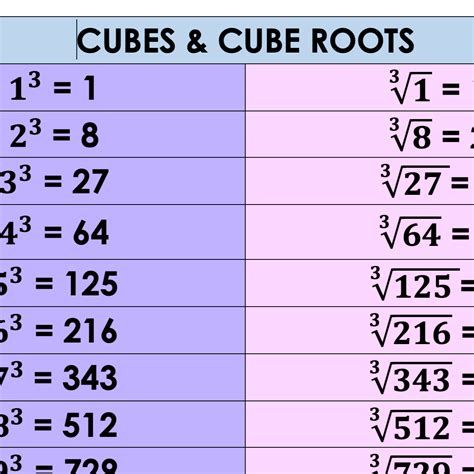Cube roots, the inverses of cubing, are an essential mathematical concept that students encounter during their academic journey. Understanding the concept of cube roots enables individuals to solve complex mathematical problems and apply their knowledge to various real-world applications.

When Do Students Learn About Cube Roots?
The introduction to cube roots typically occurs during the following school years:
- Grade 7-8: Students are introduced to the concept and basic operations involving cube roots. They learn to find cube roots of perfect cubes and understand the relationship between cubes and their corresponding cube roots.
- Grade 9 (Algebra I): Students delve deeper into cube roots and learn to solve more complex cube root problems. They also explore the use of cube roots in simplifying algebraic expressions and solving equations.
- Grade 10 (Geometry): Cube roots are utilized in geometry to determine the volumes of cubes and other three-dimensional shapes. Additionally, students explore the applications of cube roots in trigonometry and other mathematical domains.
Importance of Learning Cube Roots
Mastering cube roots is crucial for several reasons:
- Mathematical Problem-Solving: Cube roots empower students to solve a wide range of mathematical problems, including equations, inequalities, and optimization tasks.
- Real-World Applications: Cube roots find practical applications in various fields, including architecture, engineering, finance, and scientific research.
- Cognitive Development: The process of learning and understanding cube roots enhances critical thinking, problem-solving abilities, and logical reasoning.
Effective Strategies for Learning Cube Roots
- Visualize the Cube: Mentally picture the cube corresponding to the given number and relate it to the cube root.
- Use Prime Factorization: Decompose the number into prime factors and group them into sets of three. The product of the cube roots of each set represents the cube root of the original number.
- Practice Regularly: Solve numerous cube root problems to gain proficiency and build confidence.
Tips and Tricks
- Estimation: Estimate the cube root of a number by rounding it to the nearest perfect cube and then taking the cube root of that perfect cube.
- Technology: Utilize calculators or online tools to check your answers or solve more complex cube root problems.
- Real-World Examples: Look for real-world applications of cube roots to make the concept more relatable and interesting.
FAQs
- Q: Why is learning cube roots important?
- A: Cube roots enhance problem-solving abilities, have real-world applications, and promote cognitive development.
- Q: What are the different methods to find cube roots?
- A: Visualization, prime factorization, and estimation are common methods for finding cube roots.
- Q: When do students typically learn about cube roots?
- A: Cube roots are typically introduced in grades 7-8 and further explored in Algebra I, Geometry, and higher mathematics courses.
- Q: What are some common applications of cube roots?
- A: Cube roots are used in architecture, engineering, finance, scientific research, and various mathematical domains.
Conclusion
Cube roots are a fundamental mathematical concept that plays a vital role in problem-solving, real-world applications, and cognitive development. By understanding the methods to find cube roots and practicing regularly, students can gain proficiency in this essential mathematical skill. Educators and parents can support students’ learning by providing clear explanations, offering practice opportunities, and highlighting the relevance of cube roots in various domains.
